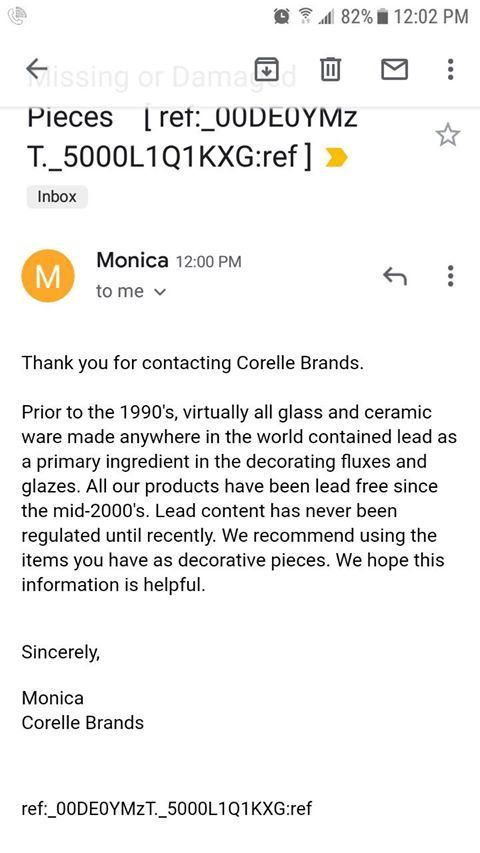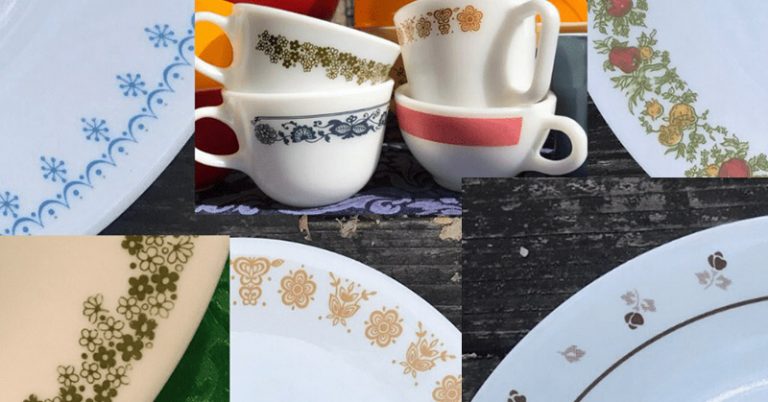The Corelle lead issue is well known now thanks to the work of a mother who was personally impacted by lead poisoning.
Tamara Rubin is a mother of four children who were affected by lead poisoning and is now an independent advocate for consumer goods safety. In 2019, she used her skills as a certified XRF analyzer to test vintage Tupperware for dangerous levels of lead and other heavy metals. Her tests came back positive, and she quickly began to warn consumers to throw away their vintage Tupperware.
She has continued to test consumer goods for high levels of heavy metals and has recently found a new offender: Corelle Dishware.
Corelle Dishes Contain Lead
The popular dishware brand, recognized by its decorative floral designs and known for its durability and resistance to breaks, has been found to test positive for lead.
Rubin tested her own collection of decorative dishes and was disappointed to find out that the paint or glaze that is used on many of the patterns contains the toxic heavy metal.
In a series of emails between Rubin and Corelle, Rubin claims a spokesperson for the company confirmed her results, stating that all of their products have been lead-free since the mid-2000s. She also said the brand’s representative attempted to limit the company’s responsibility by stating that “Prior to the 1990s, virtually all glass and ceramic ware made anywhere in the world contained Lead as a primary ingredient in the decorating fluxes and glazes.” [1]
Rubin argues that, while many vintage dishware brands used lead-based paint, to say that “virtually all” companies did so is a hyperbolic claim [1].
This email exchange is by no means a press-release or public admittance from the company, however, it’s hard to deny. You can see a screenshot taken by Tamara of Corelle’s e-mail response in the image to the right below.

Officially, Corelle also the following statement on their website:
“All Corelle® stoneware products and glazes are made of clay-based materials and glazes used throughout the industry. Decorations, if present, are made from low-lead enamels and fired at temperatures exceeding 1000 degrees F, which binds any heavy metals both physically and chemically so that their release is minimized.” [2]
The company goes on to state that at no time has Corelle brand exceeded the limit for the presence of leachable lead in their products, which is no more than 0.100 ppm (or one-tenth of one part per million). They continue to defend the brand by explaining the process by which their products are tested:
“Tests for the presence of heavy metals are conducted for Corelle Brands by internationally certified, third-party laboratories under strict conditions, by trained technicians, and using atomic absorption spectrophotometry analysis following carefully monitored preparation. These steps are necessary to minimize any possibility of contamination or false reading during preparation, testing or analysis.” [2]
The Dangers of Corelle Lead Exposure
Lead exposure occurs when its particles are breathed in, swallowed, or absorbed. Once absorbed, it is stored in our bones, blood, and tissues as a source of continual internal exposure. As you get older and your bones begin to demineralize, larger amounts of lead may be released from your bones and cause an even greater amount of internal exposure [3,4].
You can experience lead poisoning if you are exposed to large amounts of the heavy metal over a short period of time. Symptoms of acute lead poisoning could include:
- Abdominal pain
- Constipation
- Tiredness
- Headaches
- Irritability
- Loss of appetite
- Memory loss
- Pain or tingling in the hands and/or feet
- Weakness [3]
Symptoms of lead poisoning tend to occur slowly, so it can often be overlooked as the source of the problem. This can be potentially life-threatening, and very high levels of exposure could result in anemia, or kidney or brain damage [3].
Lead poisoning can also occur as a result of prolonged exposure. Someone who is exposed to lower levels of lead over a long period of time may experience:
- Abdominal pain
- Constipation
- Depression
- Distractedness
- Forgetfulness
- Irritability
- Nausea/Sickness
Chronic exposure could also put you at risk for high blood pressure, heart disease, kidney disease, and reduced fertility [3].
Children are Particularly at Risk
As seen in Tamara’s unfortunate case, children tend to be more affected by lead poisoning than adults, and exposure to the heavy metal could result in the following symptoms:
- Developmental delay
- Learning difficulties
- Irritability
- Loss of appetite
- Weight loss
- Sluggishness and fatigue
- Abdominal pain
- Vomiting
- Constipation
- Hearing loss
- Seizures
- Eating things, such as paint chips, that aren’t food (pica)
Other Sources of Lead
There are several perhaps unexpected places lead and other dangerous heavy metals, like cadmium, can be found in the United States. Jewelry and cosmetics, particularly those made for children, have been found to be frequent offenders, and a 2016 investigation found that some jewelry from popular Canadian stores Ardene and Aldo Accessories contained thousands of times more cadmium than what is considered safe [5,6]. This problem isn’t just localized to these stores either, major U.S retailers have also been affected.
Some imported medicines, foods, and candies, have been found to contain lead as well [5].
Although lead-containing paint has not been sold since the late seventies, older homes could still have it. Tiny fragments of the paint could float through the air and accumulate on surfaces in your home. This could hold true for any outdoor structures in your yard that were put up before 1978, which could end up leaching into the ground and contaminating your soil [7].
Toys, particularly if they are old or if they are cheap, could also contain heavy metals, which could be particularly dangerous if your child is prone to putting the toy in their mouth [7].
How to Limit Your Exposure to Lead
There are many ways you can minimize you and your family’s risk for exposure to lead and other heavy metals:
Keep it clean. Regularly dusting your home and cleaning surfaces with a wet sponge or rag can wipe up any lead particles that may have accumulated on them.
Remove your shoes. Lead can be tracked in from the outside, so take off your shoes before entering the house.
Wash your hands. This is especially true for young children, who tend to put their hands in their mouths.
Wash frequently. Any item, like a toy, pacifier, or bottle, that frequently goes into your child’s mouth should be washed frequently.
Eat well. People who eat a healthier diet seem to absorb less lead than those who don’t.
Test regularly. Since lead poisoning can be hard to detect, routine testing is the only way to be sure your child hasn’t been affected and is recommended for children under five years old.
If you suspect there might be lead paint in your home or on your property, you can call your local health department to have your home and your soil tested for lead. You can also check www.recalls.gov to check if any of your child’s toys have been recalled due to contamination [3].
Use Corelle Plates for Decorative Use Only
Corelle is now a market leader in creating lead-free dishware, but Rubin recommends using the plain white versions of their products since they are the most consistently lead-free options available. Secondly, she also mentions that certain colors still test positive for cadmium. As for the decorative dishes she already owns, the company recommended to her that she use them as decorative pieces only.
Sources
- ‘CORELLE® FAQS’ Corelle Brands
- ‘LEAD’ CDC
- ‘Contribution of tissue lead to blood lead in adult female subjects based on stable lead isotope methods’ Pubmed B L Gulson et al. Published June, 1995
- ‘Unusual Sources of Lead Poisoning’ Poison Control
- ‘Toxic jewelry: Cadmium found in Ardene, Aldo products’ CBC Sarah Bridge. Published January 15, 2016
- ‘5 Surprising Sources of Lead Exposure’ WebMD Dan Brennan, MD. Published October 16, 2019

